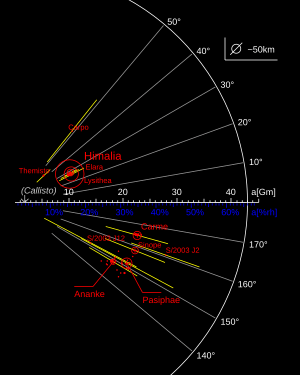Pasiphae group facts for kids
The Pasiphae group is a family of moons that orbit the giant planet Jupiter. These moons are called irregular satellites because they have unusual orbits. They also move in a backward direction compared to most moons, meaning they orbit Jupiter in the opposite way Jupiter spins. All moons in this group are believed to have come from the same original object.
These moons travel far from Jupiter, about 22.8 to 24.1 million kilometers away. Their paths around Jupiter are also tilted quite a bit, between 144.5° and 158.3°. The shape of their orbits is not perfectly round, but more oval, with an eccentricity between 0.25 and 0.43.
The main members of the Pasiphae group are listed below. The negative numbers for their orbital period mean they orbit Jupiter in a backward direction.
| Name | Diameter (km) |
Period (days) |
Notes |
|---|---|---|---|
| Pasiphae | 57.8 | −722.34 | The biggest moon in the group |
| Sinope | 35 | −777.29 | Has a reddish color |
| Callirrhoe | 9.6 | −787.43 | Has a reddish color |
| Megaclite | 5 | −747.09 | Has a reddish color |
| Autonoe | 4 | −719.01 | |
| Eurydome | 3 | −722.59 | |
| Sponde | 2 | −734.89 |
The International Astronomical Union (IAU) is the group that names moons and other space objects. They have a rule that all moons orbiting backward (retrograde moons) must have names that end with the letter -e.
How the Pasiphae Group Formed
Scientists believe the Pasiphae group formed when Jupiter's strong gravity captured a large asteroid. After being captured, this asteroid likely broke into many pieces because of a collision with another object.
The original asteroid was probably about 60 kilometers wide, which is close to the size of Pasiphae itself. Pasiphae still holds about 99% of the original asteroid's mass. However, if Sinope is also part of this group, then Pasiphae would hold only about 87% of the original mass.
Not all scientists agree that the Pasiphae group formed from just one collision. This is because, even though the moons are about the same distance from Jupiter, their orbital tilts are quite different. Some think that Sinope might have been captured by Jupiter on its own, not as part of the same breakup event. Also, the moons have different colors (Pasiphae is grey, while Callirrhoe and Megaclite are light red). These color differences also suggest that the group's origin might be more complicated than a single crash.
See also
 In Spanish: Grupo de Pasífae para niños
In Spanish: Grupo de Pasífae para niños




